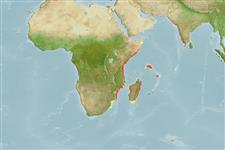Common names from other countries
>
Mulliformes (Goatfishes) >
Mullidae (Goatfishes)
Etymology: Parupeneus: Latin, parum, parvum = small + Peneus, the name of a river; minys: Name from the Greek word for small, referring to its very small adult size for this genus..
More on authors: Randall & Heemstra.
Environment: milieu / climate zone / depth range / distribution range
экология
морской ассоциированный с рифами; пределы глубины 43 - 55 m (Ref. 82838). Tropical
Western Indian Ocean: Mozambique, Seychelles and India.
Size / Вес / Возраст
Maturity: Lm ? range ? - ? cm
Max length : 10.7 cm SL самец/пол неопределен; (Ref. 82838); 8.4 cm SL (female)
Краткое описание
определительные ключи | морфология | морфометрия
колючие лучи спинного плавника (общее число) : 8; членистые (мягкие) лучи спинного плавника (общее число) : 9; колючие лучи анального плавника: 0; членистые (мягкие) лучи анального плавника: 7; позвонки: 24. This species is distinguished by the following characters: pectoral-fin rays 15-16; gill rakers 6 + 21-22; elongated body, depth 3.95-4.3 in SL; head length 2.9-3.05 in SL; interorbital space flat medially; snout length 2.05-2.3 in HL; posterior edge of maxilla symmetrically convex with maximum depth of maxilla 5.45-5.8 in HL; barbel length 1.35-1.45 in HL; the longest dorsal spine 1.8-1.95 in HL; pectoral fins 1.3-1.4 in HL; pelvic fins 1.5-1.65 in HL; colour of alcohol preserved specimens uniform tan except those from the Seychelles with areas of white ventrally on head below eye and on lower two/fifths of body; dark markings absent; translucent fins pale yellowish. Colour when fresh, pink dorsally, pale pink to white ventrally, with an indistinct pale yellow stripe along lateral line; some lateral-line scales with a bluish white dash; a bluish white line encircling ventral part of eye and continuing obliquely to upper lip; 3 small bluish white blotches dorsally on head, one directly above eye; barbels white; median and pelvic fins translucent blotchy yellow with small pale blue to whitish spots along rays that outline faint transverse yellowish bands (Ref. 82838).
Life cycle and mating behavior
Maturities | размножение | Spawnings | Egg(s) | Fecundities | личинки
Randall, J.E. and E. Heemstra, 2009. Three new goatfishes of the genus Parupeneus from the Western Indian Ocean, with resurrection of P. seychellensis. Smithiana Bulletin 10:37-50. (Ref. 82838)
Статус Красного Списка МСОП (Ref. 130435)
CITES (Ref. 128078)
Not Evaluated
Угроза для людей
Harmless
Использование человеком
дополнительная информация
инструменты
Специальные отчеты
Скачать в формате XML
ресурсы в Интернет
Estimates based on models
Preferred temperature (Ref.
115969): 25.5 - 26.1, mean 26.1 (based on 3 cells).
Phylogenetic diversity index (Ref.
82804): PD
50 = 0.5000 [Uniqueness, from 0.5 = low to 2.0 = high].
Bayesian length-weight: a=0.01202 (0.00556 - 0.02601), b=3.10 (2.93 - 3.27), in cm Total Length, based on LWR estimates for this Genus-body shape (Ref.
93245).
Trophic level (Ref.
69278): 3.3 ±0.4 se; based on size and trophs of closest relatives
устойчивость к внешним воздействиям (Ref.
120179): высокий, минимальное время удвоения популяции до 15 месяцев (Preliminary K or Fecundity.).
Fishing Vulnerability (Ref.
59153): Low vulnerability (10 of 100).
